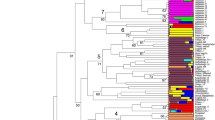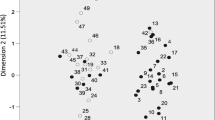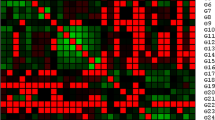Abstract
A total of 158 almond accessions representative of the diversity of almond across the five continents were included for analysis using 17 microsatellite polymorphic markers. Genetic relationships among genotypes were estimated using cluster analysis, allowing their differentiation in two main groups, one with the domesticated almond cultivars and selections and the other with all wild Prunus species close to almond. The unweighted pair group method average tree drawn from this analysis classified the genotypes according to their geographical origin, confirming the particular evolution of different almond ecotypes. Structure analysis showed a strong subpopulation structure and linkage disequilibrium decaying with increasing genetic linkage distance. Analysis of molecular variance confirmed that most of the genetic variability was within populations. Therefore the connection structure between the different populations and the possible bottlenecks in the expansion of almond cultivars could be established.







Similar content being viewed by others
References
Arunyawat U, Capdeville G, Decroocq V, Mariette S (2012) Linkage disequilibrium in French wild cherry germplasm and worldwide sweet cherry germplasm. Tree Genet Genomes 8:737–755
Asai WK, Micke WC, Kester DE, Rough D (1996) The evaluation and selection of current varieties. In: Micke WC (ed) Almond production manual, vol 3364. University of California Publication, California, pp 52–60
Barnaud A, Laucou V, This P, Lacombe T, Doligez A (2010) Linkage disequilibrium in wild French grapevine Vitis vinifera L. subsp. silvestris. Heredity 104:431–437
Brookfield JFY (1996) A simple new method for estimating null allele frequency from heterozygote deficiency. Mol Ecol 5:453–455
Coart E, Van Glabeke S, De Loose M, Larsen AS, Roldan-Ruiz I (2006) Chloroplast diversity in the genus Malus: new insights into the relationship between the European wild apple [Malus sylvestris (L.) Mill.] and the domesticated apple (Malus domestica Borkh.). Mol Ecol 15:2171–2182
Comadran J, Thomas WTB, van Eeuwijk FA, Ceccarelli S, Grando S, Stanca AM, Pecchioni N, Akar T, Al-Yassin A, Benbelkacem A, Ouabbou H, Bort J, Romagosa I, Hackett CA, Russell JR (2009) Patterns of genetic diversity and linkage disequilibrium in a highly structured Hordeum vulgare association-mapping population for the Mediterranean basin. Theor Appl Genet 119:175–187
Elhamzaoui A, Ouklabi A, Charafi J, Moumni M (2012) Assessment of genetic diversity of Moroccan cultivated almond (Prunus dulcis Mill. DA Webb) in its area of extreme diffusion, using SSR markers. Am J Plant Sci 3:1294–1303
Evanno G, Regnaut S, Goudet J (2005) Detecting the number of clusters of individuals using the software STRUCTURE: a simulation study. Mol Ecol 14:2611–2620
Felber F, Kozlowski G, Arrigo N, Guadagnuolo R (2007) Genetic and ecological consequences of transgene flow to the wild flora. Adv Biochem Eng Biotechnol 107:173–205
Felipe AJ (1984) État de l’arboretum des espèces sauvages à Saragosse. Considérations sur l’utilisation de ce matériel botanique. Options Méditerranéennes CIHEAM/IAMZ 84/II, 203–204
Felsenstein J (2005) PHYLIP (Phylogeny Inference Package) version 3.6. Distributed by the author. Department of Genome Sciences, University of Washington, Seattle
Fernandez i Marti A, Athanson B, Koepke T, Font i Forcada C, Dhingra A, Oraguzie N (2012) Genetic diversity and relatedness of sweet cherry cultivars based on SNP markers. Front Plant Sci. doi:10.3389/fpls.2012.00116
Fernández i Martí A, Alonso JM, Espiau MT, Rubio-Cabetas MJ, Socias i Company R (2009) Genetic diversity in Spanish and foreign almond germplasm assessed by molecular characterization with simple sequence repeats. J Am Soc Hort Sci 134:535–542
Flint-Garcia SA, Thornsberry JM, Buckler ES (2003) Structure of linkage disequilibrium in plants. Ann Rev Plant Biol 54:357–374
Font i Forcada C, Oraguzie N, Igartua E, Moreno MA, Gogorcena Y (2013) Population structure and marker-trait associations for pomological traits in peach and nectarine cultivars. Tree Genet Genomes 9:331–349
Gradziel TM (2011) Origin and dissemination of almond. Hort Rev 38:23–81
Grasselly C, Crossa-Raynaud P (1980) L’amandier. G.P. Maisonneuve et Larose. Maisonneuve et Larose, Paris
Haudry A, Cenci A, Ravel C, Bataillon T, Brunel D, Poncet C, Hochu I, Poirier S, Santoni S, Glemin S, David J (2007) Grinding up wheat: a massive loss of nucleotide diversity since domestication. Mol Biol Evol 24:1506–1517
Kester DE, Gradziel TM, Grasselly C (1990) Almonds (Prunus). Acta Hortic 290:699–758
Kovalyov NV, Kostina KF (1935) A contribution to the study of the genus Prunus Focke. Questions of taxonomy and plant breeding (in Russian). Trudy po Prikladnoj Botanike Genetike i Selektsii, Serie 8, 4, 1–76
Kuleung C, Baenzinger PS, Dweikat I (2004) Transferability of SSR markers among wheat, rye and triticale. Theor Appl Genet 108:1147–1150
Ledig FT (1992) Human impacts on genetic diversity in forest ecosystems. Oikos 63:87–108
Martínez-Gómez P, Arulsekar S, Potter D, Gradziel TM (2003) An extended interspecific gene pool available to peach and almond breeding as characterized using simple sequence repeat (SSR) markers. Euphytica 131:313–322
Mather KA, Caicedo AL, Polato NR, Olsen KM, McCouch S, Purugganan MD (2007) The extent of linkage disequilibrium in rice (Oryza sativa L.). Genetics 177:2223–2232
Meirmans PG, van Tienderen PH (2004) GENOTYPE and GENODIVE: two programs for the analysis of genetic diversity of asexual organisms. Mol Ecol Notes 4:792–794
Mnejja M, Garcia-Mas J, Audergon JM, Arús P (2010) Prunus microsatellite marker transferability across rosaceous crops. Tree Genet Genomes 6:689–700
Nei M, Li WH (1979) Mathematical model for studying genetic variation interms of restriction endonucleases. Proc Natl Acad Sci USA 76:5269–5273
Nordborg M, Tabaré S (2002) Linkage disequilibrium: what history has to tell us. Trends Genet 18:83–90
Ostrowski MF, David J, Santoni S, McKhann H, Reboud X, Le Corre V, Camilleri C, Brunel D, Bouchez D, Faure B, Bataillon T (2006) Evidence for a large-scale population structure among accessions of Arabidopsis thaliana: possible causes and consequences for the distribution of linkage disequilibrium. Mol Ecol 15:1507–1517
Popov MG, Kostina KF, Poyarkova AI (1929) Wild trees and shrubs in Central Asia (in Russian). Trudy po Prikladnoj Botanike Genetike i Selektsii 2:241–483
Pritchard JK, Stephens M, Rosenberg NA, Donnelly P (2000) Association mapping in structured populations. Am J Hum Genet 67:170–181
Quinn G (1905) Some notes on almonds. Department of Agriculture of South Australia, Bulletin 5
Rehder A (1940) Manual of cultivated trees and shrubs. MacMillan, New York
Remington DL, Thornsberry JM, Matsuoka Y, Wilson LM, Whitt SR, Doebley J, Kresovich S, Goodman MM, Buckler ES (2001) Structure of linkage disequilibrium and phenotypic associations in the maize genome. Proc Natl Acad Sci USA 98:11479–11484
Rikhter AA (1972) Biological basis for the creation of almond cultivars and commercial orchards (in Russian). Akademiya Nauk SSSR Glavnyj Botanicheskij Sad, Moscow
Saitou N, Nei M (1987) The neighbour-joining method: a new method for reconstructing phylogenetic trees. Mol Biol Evol 4:406–425
Shepherd T (1841) Lecture on the horticulture of Australia. In: Allen J (ed) The South Australia magazine, vol 1., July 1841—September 1842, South Australia, Adelaide, pp 148–150
Socias i Company R (2004) The contribution of Prunus webbii to almond evolution. Plant Genet Resour News 14:9–13
Socias i Company R, Felipe AJ (1992) Almond: a diverse germplasm. HortScience 27:717–718
Socias i Company R R (1990) Breeding self-compatible almonds. Plant Breed Rev 8:313–338
Socias i Company R, Alonso JM, Kodad O, Gradziel TM (2012) Almond. In: Badenes ML, Byrne D (eds) Fruit breeding, handbook of plant breeding 8. Springer, Heidelberg, pp 697–728
van Heerwaarden J, Doebley J, Briggs WH, Glaubitz JC, Goodman MM, Sánchez González JJ, Ross-Ibarra J (2011) Genetic signals of origin, spread, and introgression in a large sample of maize landraces. Proc Natl Acad Sci USA 108:1088–1092
Wirthensohn M, Sedgley M (2003) Australian almond cultivars: where are they? Australian Nutgrower 17:16
Acknowledgments
Research conducted under the Spanish projects AGL2010-22197-C02-01 and INIA RF2011-00020-C02-01, and the Research Group A12 of Aragón.
Author information
Authors and Affiliations
Corresponding author
Additional information
Angel Fernández i Martí and Carolina Font i Forcada have contributed equally to this work.
Electronic supplementary material
Below is the link to the electronic supplementary material.
Rights and permissions
About this article
Cite this article
Fernández i Martí, A., Font i Forcada, C., Kamali, K. et al. Molecular analyses of evolution and population structure in a worldwide almond [Prunus dulcis (Mill.) D.A. Webb syn. P. amygdalus Batsch] pool assessed by microsatellite markers. Genet Resour Crop Evol 62, 205–219 (2015). https://doi.org/10.1007/s10722-014-0146-x
Received:
Accepted:
Published:
Issue Date:
DOI: https://doi.org/10.1007/s10722-014-0146-x




